Gregory A. Fournier's Blog, page 22
January 12, 2018
Connie Kalitta "The Bounty Hunter" vs. Shirley "Cha-Cha" Muldowney
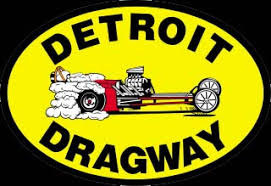
Baby Boomers who grew up in the Detroit area and listened to Windsor radio station CKLW were familiar with advertisements for the Detroit Dragway located at Sibley and Dix. The ads always began with "Saturday, SATURDAY NIGHT, at the DETROIT DRAGWAY." Then the card for the automotive duels would be hyped. If you don't remember or aren't old enough to know what I'm talking about, I have a link to an audio at the end of this post.
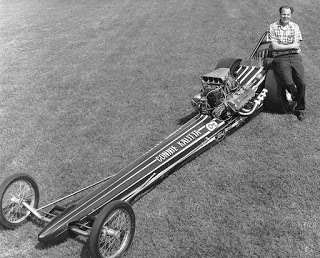 Connie Kalitta with top fuel dragster in 1967.Two of the most popular drag racers of the 1970s and 1980s were Connie Kalitta "The Bounty Hunter" and Shirley "Cha-Cha" Muldowney. Connie was from Mount Clemens, Michigan, and Shirley was from Schenectady, New York. They shared a professional and personal relationship from 1972-1977. Connie gave Shirley a Funny Car he no longer raced and acted as her crew chief for many of her early races. In those days, Shirley was known as "The Huntress."
Connie Kalitta with top fuel dragster in 1967.Two of the most popular drag racers of the 1970s and 1980s were Connie Kalitta "The Bounty Hunter" and Shirley "Cha-Cha" Muldowney. Connie was from Mount Clemens, Michigan, and Shirley was from Schenectady, New York. They shared a professional and personal relationship from 1972-1977. Connie gave Shirley a Funny Car he no longer raced and acted as her crew chief for many of her early races. In those days, Shirley was known as "The Huntress." Kalitta began drag racing when he was a sixteen-year-old student at Mount Clemens High School. He worked himself up the ranks of the National Hot Rod Association (NHRA) to become one of the sport's top drivers. Known as The Bounty Hunter, Kalitta was the first driver to reach 200 mph in a sanctioned NHRA event. In 1989 at the Winter Nationals, Kalitta was the first driver to break the 290 mph barrier with a 291.54 mph qualifying run.
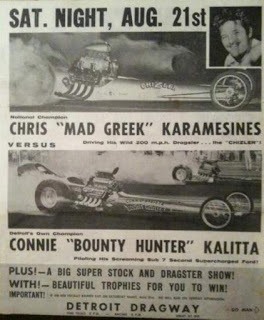 In all, Kalitta won ten national titles and was inducted into the Motorsports Hall of Fame of America in 1992. The NHRA compiled a list of the Top 50 Drivers for their fiftieth-anniversary in 2001. Kalitta ranked 21st on the all-time list, and in 2016, he became the first recipient of the NHRA's Lifetime Achievement Award.
In all, Kalitta won ten national titles and was inducted into the Motorsports Hall of Fame of America in 1992. The NHRA compiled a list of the Top 50 Drivers for their fiftieth-anniversary in 2001. Kalitta ranked 21st on the all-time list, and in 2016, he became the first recipient of the NHRA's Lifetime Achievement Award. Kalitta's first NHRA win came in 1964 in Bakersfield, California. In 1967, he won his first NHRA title. With the prize money, he bought his first airplane--a Cessna 310--and started his company Kalitta Air at the Willow Run Airport shipping freight for the Ford Motor Company (FoMoCo)--his racing sponsor.
 Kalitta Air and Kalitta Motorsports company photograph.For a time, Kalitta retired from racing and directed his attention toward building up his air freight business. Now he has a fleet of about 100 planes, many of them 747s. In addition to a bread-and-butter FoMoCo parts distribution contract, Kalitta Air provides charter flights for Medical Flight Services, Air Ambulance Specialists, the Shriners' Children's Hospital and the United States Department of Defense, to name a few. It is not generally known that Kalitta Air keeps a 747 on standby to work with the military to return fallen service men and women to their homes.
Kalitta Air and Kalitta Motorsports company photograph.For a time, Kalitta retired from racing and directed his attention toward building up his air freight business. Now he has a fleet of about 100 planes, many of them 747s. In addition to a bread-and-butter FoMoCo parts distribution contract, Kalitta Air provides charter flights for Medical Flight Services, Air Ambulance Specialists, the Shriners' Children's Hospital and the United States Department of Defense, to name a few. It is not generally known that Kalitta Air keeps a 747 on standby to work with the military to return fallen service men and women to their homes.Kalitta no longer races, but he is the CEO of Kalitta Motorsports in Ypsilanti, Michigan which sponsors four cars and drivers. His love of racing became a lifelong pursuit and a way of life.
***
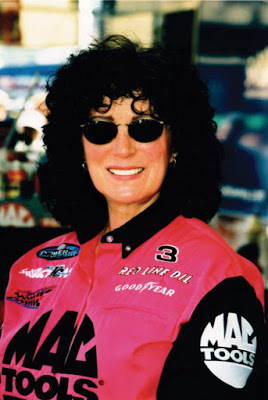 Shirley MuldowneyConnie Katilla first met Shirley Muldowney in 1966 at Raceway Park in Illinois when she was racing a dragster with her husband as her mechanic. In 1972, Shirley divorced Jack Muldowney when she wanted to advance to top fuel funny cars, and he refused to live the life of a Gypsy to compete on the NHRA circuit. Doubtless, there were other personal issues as Shirley moved in with Kalitta in 1972.Kalitta was The Bounty Hunter and Muldowney became The Huntress. Connie soon tagged Shirley with the nickname "Cha-Cha" which she never liked, but it became part of her NHRA branding.
Shirley MuldowneyConnie Katilla first met Shirley Muldowney in 1966 at Raceway Park in Illinois when she was racing a dragster with her husband as her mechanic. In 1972, Shirley divorced Jack Muldowney when she wanted to advance to top fuel funny cars, and he refused to live the life of a Gypsy to compete on the NHRA circuit. Doubtless, there were other personal issues as Shirley moved in with Kalitta in 1972.Kalitta was The Bounty Hunter and Muldowney became The Huntress. Connie soon tagged Shirley with the nickname "Cha-Cha" which she never liked, but it became part of her NHRA branding.After her split from Kalitta, Shirley went on to make a name for herself in this macho male sport. At first, she had trouble attracting sponsors and finding a crew that would work with a woman. But when Shirley "Cha-Cha" Muldowney showed up at the track with her hot pink car, cowboy boots, and crash helmet, she started filling the grandstands. Even her pit crew wore hot pink team shirts.
 Muldowney defied traditional gender stereotypes head-on and challenged sexism in the racing culture like Billie Jean King had for tennis in 1973's Battle of the Sexes against Bobby Riggs. Both ladies proved women can compete in a man's world.
Muldowney defied traditional gender stereotypes head-on and challenged sexism in the racing culture like Billie Jean King had for tennis in 1973's Battle of the Sexes against Bobby Riggs. Both ladies proved women can compete in a man's world.Shirley Muldowney was the first woman to receive a NHRA license to drive top fuel dragsters. She was the first person--man or woman--to win three NHRA national events in a row. In 1980, Shirley won the World Finals by beating her nemesis Connie Kalitta, and in 1982, she won an unprecedented third NHRA Top Fuel Championship.
 Muldowney's achievements were not lost on Hollywood. She got the big screen treatment in 1983's Heart Like a Wheel starring Bonnie Bedelia as Muldowney and Beau Bridges as Connie Kalitta. Muldowney has said the film didn't capture her real life very well but was good for the sport.
Muldowney's achievements were not lost on Hollywood. She got the big screen treatment in 1983's Heart Like a Wheel starring Bonnie Bedelia as Muldowney and Beau Bridges as Connie Kalitta. Muldowney has said the film didn't capture her real life very well but was good for the sport.On the heels of her celebrity, Muldowney was faced with her biggest challenge. In June of 1984, her dragster crashed at over 250 mph at Sanair Speedway near Montreal, Canada. A front tire shredded and got twisted up in a wheel causing the car to lose control for 600 feet before crashing. Shirley was left with broken legs, crushed hands, a shattered pelvis, and a severed thumb. Determined to race again, she undertook two years of grueling physical therapy and recovery. Her first race back was against "Big Daddy" Don Garlits--a personal friend of hers. She lost.
Because of trouble attracting sponsors, Shirley retired from racing in 2003. During her career, she won eighteen NHRA National events and was ranked 5th on NHRA's 2001 list of its Top 50 Drivers earning her the title of "First Lady of Drag Racing." Her memoir Shirley Muldowney: Tales from the Track was released in 2005 depicting her drag racing life. The same year, Muldowney was inducted into the Automotive Hall of Fame.
*** CKLW radio commercial for the Detroit Dragway from 1966: https://www.youtube.com/watch?v=BbrdImfvFmQ
1982 U.S. Nationals Championship drag race between Kalitta and Muldowney: https://www.youtube.com/watch?v=2-Q8f6bsfI0
Muldowney on the Johnny Carson Show in 1986 after her 1984 catastrophic car crash: https://www.youtube.com/watch?v=1FeaqiczHzI
Published on January 12, 2018 06:46
January 6, 2018
Ypsilanti Village Growing Pains
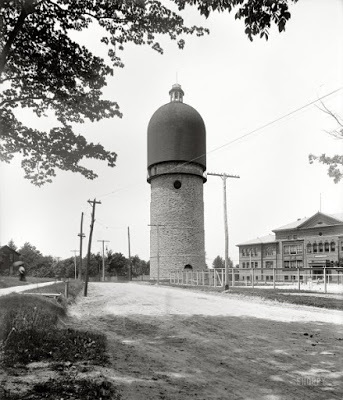 Ypsilanti's Water Tower with cuppola before it was removed for safety reasons.
Ypsilanti's Water Tower with cuppola before it was removed for safety reasons. Once the Village of Ypsilanti was chartered by the Michigan Legislature in 1832, growth was steady. But the cholera epidemic of 1836 in Detroit forced Ypsilanti residents to take drastic measures prohibiting travelers from entering their town. Local militiamen were stationed at Bowen’s Tavern three miles east of the village on Chicago Road.
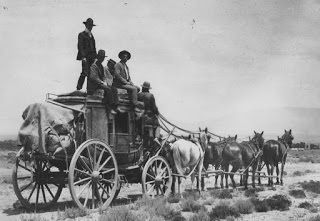 When a stagecoach from Detroit was stopped and barred from entering the village, the teamster attempted to run the blockade when a militiaman shot the lead horse in the head. The horse fell but was only stunned. The lead ball glanced off his skull. The horse was helped to its feet and the angry driver stubbornly pressed forward. The news of the stagecoach incident traveled quickly filling passengers with apprehension. A detour around the village was quickly established and mail service was interrupted. Ypsilanti remained cholera-free, but outsiders were left with the lasting impression that the village was unfriendly and dangerous.
When a stagecoach from Detroit was stopped and barred from entering the village, the teamster attempted to run the blockade when a militiaman shot the lead horse in the head. The horse fell but was only stunned. The lead ball glanced off his skull. The horse was helped to its feet and the angry driver stubbornly pressed forward. The news of the stagecoach incident traveled quickly filling passengers with apprehension. A detour around the village was quickly established and mail service was interrupted. Ypsilanti remained cholera-free, but outsiders were left with the lasting impression that the village was unfriendly and dangerous. 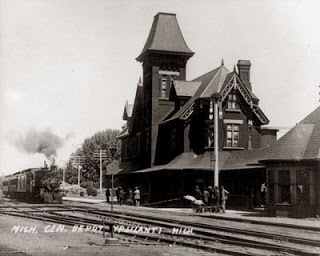 Michigan Central DepotMichigan Central train service was inaugurated on February 2, 1838. Ypsilanti was connected to the rest of the state and became the economic hub for the area’s growing agricultural concerns. The coming of the railroad divided Ypsilanti into two distinct commercial districts. The West Side of the river was dominated by downtown merchants on the Chicago road. The East Side had the train station and developed Depot Town catering to train passengers and light manufacturing.
Michigan Central DepotMichigan Central train service was inaugurated on February 2, 1838. Ypsilanti was connected to the rest of the state and became the economic hub for the area’s growing agricultural concerns. The coming of the railroad divided Ypsilanti into two distinct commercial districts. The West Side of the river was dominated by downtown merchants on the Chicago road. The East Side had the train station and developed Depot Town catering to train passengers and light manufacturing. The State Legislature chartered Michigan State Normal College in 1849 to be the first teacher training institution west of the Alleghenies. Its mission was to “normalize” public school instruction and set educational standards throughout the state. The college was constructed on Ypsilanti’s high ground on the West Side and eventually became Eastern Michigan University.
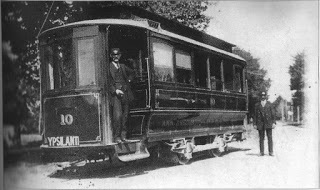 Ypsi-Ann TrolleyElectricity began powering the city in 1887, and a new water-pumping station made possible Ypsilanti’s most prominent feature, the Water Tower, built across from the Normal College. In 1890, the popular Ypsi-Ann steam-driven trolley made travel between the two college towns possible. The Normal College was attended mainly by young women, and the University of Michigan was attended mainly by young men. It was said that the weekends brought a rough parody between the genders. Because the steam-driven trolley cars were loud and scared the horses, the trolley line was soon electrified. In 1898, the Ypsi-Ann connected to Detroit’s Interurban to the east and Saline and Jackson to the west.
Ypsi-Ann TrolleyElectricity began powering the city in 1887, and a new water-pumping station made possible Ypsilanti’s most prominent feature, the Water Tower, built across from the Normal College. In 1890, the popular Ypsi-Ann steam-driven trolley made travel between the two college towns possible. The Normal College was attended mainly by young women, and the University of Michigan was attended mainly by young men. It was said that the weekends brought a rough parody between the genders. Because the steam-driven trolley cars were loud and scared the horses, the trolley line was soon electrified. In 1898, the Ypsi-Ann connected to Detroit’s Interurban to the east and Saline and Jackson to the west.Meanwhile, the East Side developed dams and river races along the Huron to power a wool carding factory, a flour mill, grist mills, an underwear factory, a cabinetry shop, and a carriage manufacturer. With the discovery of mineral springs on the East Side in 1882, several sanitariums were established said to cure cancer, rheumatism, skin ailments, and even "women's trouble." Ypsilanti shipped mineral soap, distilled salts, and carbonated mineral water nationwide.
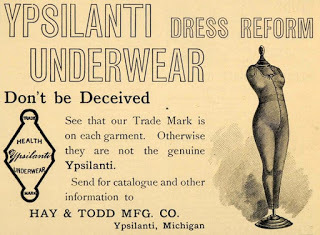 Specializing in long underwear with a flap in the back.
Specializing in long underwear with a flap in the back.The First National Bank of Ypsilanti was founded in 1864 by Daniel L. Quirk, Cornelius Cornwell, and Asa Dow. These were boom times for Ypsilanti. Many of the city’s most successful entrepreneurs built their mansions along the western bluff of the Huron River looking down at what was once Godfroy’s on the Pottawatomie and a gathering place for Native Americans. The Daniel L. Quirk mansion would eventually become the Ypsilanti City Hall; the Asa Dow mansion would become the Ypsilanti Historical Society, and the John and Mary Ann Starkweather mansion would become the Ladies Library Association.
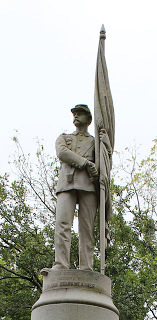 Higland Cemetery MemorialWhen the winds of war stirred, the young men of Washtenaw County answered their country’s call. Troops assembled on the Depot Town train platform before shipping out to the Civil War, the Spanish American War, and World War I. After World War I, a period of economic optimism spread throughout much of America, but by the end of the decade, the bottom fell out of the economy and Ypsilanti with the rest of the country was thrust into the Great Depression.
Higland Cemetery MemorialWhen the winds of war stirred, the young men of Washtenaw County answered their country’s call. Troops assembled on the Depot Town train platform before shipping out to the Civil War, the Spanish American War, and World War I. After World War I, a period of economic optimism spread throughout much of America, but by the end of the decade, the bottom fell out of the economy and Ypsilanti with the rest of the country was thrust into the Great Depression. The Ypsilanti community knew hardship and uncertainty before. Their first major disaster happened on March 28, 1851, a great fire destroyed much of downtown. The wooden buildings were soon rebuilt in brick. Ypsilanti’s second disaster occurred April 12, 1893, when a cyclone tore through town. Power lines went down, trees were uprooted, and homes were carried away with their belongings. The community came together and rebuilt once again. Ypsilanti was always able to rally and rise above its afflictions.
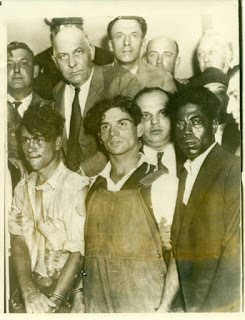 Heavy security during Torch Murder trial.But train stations during the Depression were magnets for the displaced and the shiftless. The decade of the 1930s were lean and desperate times for many. In 1931, three unemployed vagrants were out drinking one night searching for someone to rob. They came upon four Ypsilanti teens "parking" south of Ford Lake near Tuttle Hill. The teens were terrorized before being shot to death; then, their bodies were placed in the car, moved to another location, and doused with gasoline. When the bodies were found, they were unrecognizable. The three murderers were quickly captured, convicted, and sent to Jackson prison under heavy guard to prevent a lynching.
Heavy security during Torch Murder trial.But train stations during the Depression were magnets for the displaced and the shiftless. The decade of the 1930s were lean and desperate times for many. In 1931, three unemployed vagrants were out drinking one night searching for someone to rob. They came upon four Ypsilanti teens "parking" south of Ford Lake near Tuttle Hill. The teens were terrorized before being shot to death; then, their bodies were placed in the car, moved to another location, and doused with gasoline. When the bodies were found, they were unrecognizable. The three murderers were quickly captured, convicted, and sent to Jackson prison under heavy guard to prevent a lynching.As disturbing as the Torch Murders were, the isolated murder of a seven-year-old boy found frozen under the Frog Island footbridge in 1935 gripped the conscience of Ypsilanti residents like nothing had before. Every parent warned their children to avoid Depot Town, especially since the murderer of Richard Streicher, Jr. was still at large.
Harry Bennet's Role in the Torch Murders: https://fornology.blogspot.com/2013/12/harry-bennetts-role-in-ypsilanti-torch.html
Published on January 06, 2018 06:56
December 30, 2017
Ypsilanti Beginings
 Whitetail deer in the North woods marking his territory.
Whitetail deer in the North woods marking his territory.The land along the Huron River which became Ypsilanti, Michigan was surrounded by a vast stretch of primeval forest broken only by lakes, marshland, and occasional open tracts of land early settlers called “oak openings.” The ground cover was a tangle of rugged shrubbery blanketed by a deep carpet of fallen leaves decomposing into rich soil the region became known for. Herds of deer and solitary black bears roamed the countryside while smaller game lived in the treetops and along the river banks. Fish, crawdads, and snapping turtles plied the river currents.
The open area where the Huron River bends and narrows at the shallows was a crossroad and neutral ground for the Chippewa, Pottawatomie, Ottawa, and Wyandot (Huron) Native Americans. The area was not a permanent home of any particular tribe, but the Hurons--as the French dubbed them--were known to have a burial ground on the west side of the Huron River.
 Birch bark canoeThere were only two ways to enter the area: by river with birch bark canoe or by foot on the Pottawatomie Trail, which followed the Huron River Valley from the head waters of Lake Erie. This ancient Indian pathway led to the heartland avoiding most terrain and water impediments.
Birch bark canoeThere were only two ways to enter the area: by river with birch bark canoe or by foot on the Pottawatomie Trail, which followed the Huron River Valley from the head waters of Lake Erie. This ancient Indian pathway led to the heartland avoiding most terrain and water impediments.In 1809, three French pioneers Gabriel Godfroy, Francois Pepin, and Romaine La Cambre built and operated an Indian trading post named Godfroy’s on the Pottawatomie where the tribes traveled east and west at the Huron River crossing. The trading post bartered gaudy trinkets, steel knives, hand-held farm implements, and small kegs of whiskey for beaver, muskrat, bear, deer, fox, and otter pelts. Native American handicrafts were also traded for American goods brought in from Detroit by pack horse on the Pottawatomie Trail.
Two years later, the three Frenchmen, and the adult children of Godfroy were issued four tracts of land under the seal of President James Madison known as the original French Claims. Each claim was approximately a half mile wide and two miles long with the Huron River as its eastern boundary. The four claims included two square miles or about 2,500 acres. The trading post burned down in 1815 but was quickly rebuilt. In 1819, Native Americans began moving westward as European civilization encroached. With the conclusion of the Treaty of Paris, Lower Michigan fell out of Native American hands forever. By 1820, the trading post was abandoned and left in ruins.
Meanwhile in Sandusky, Ohio, Benjamin Woodruff’s wife inherited several hundred dollars from her grandfather’s estate. She and her husband decided to invest the windfall where land was cheap--that was Michigan Territory. In the spring of 1823, Benjamin Woodruff, his brother-in-law William Eiclor, Oronte Grant, and Hiram Tuttle decided to improve their lot and set out on the old Indian trail at Lake Erie in search of land to homestead. The group was outfitted with a wagon loaded with provisions and a large number of cattle belonging to Grant and Tuttle. Each of the men had a stake in the success of this venture. The group lodged with former neighbors from Sandusky, who then lived in Monroe, Michigan. They were familiar with the countryside of Southern Michigan and suggested a clearing near the ruins of Godfroy’s on the Pottawatomie as a favorable location for a settlement. The pioneers sold much of their cattle to finance their enterprise but retained enough livestock for their new farms. They headed into the interior of Michigan Territory; first on a flat-bottomed boat that the men used poles to power their cargo upstream.
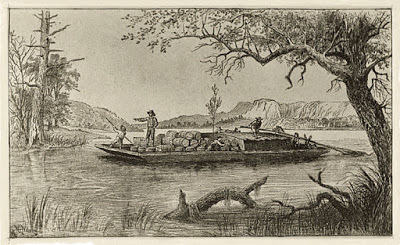 Where the waterway narrowed and the current was too strong, the men offloaded their wagon, reloaded their supplies, and continued west on foot. A couple of days later, the party came upon a suitable stretch of land southeast of the old trading post. The open plain there would be easy to cultivate. The men decided to stake their claims which would soon become their homes and small farms. They hewed out a log cabin from trees cleared from the land which was the first home of several built that year.
Where the waterway narrowed and the current was too strong, the men offloaded their wagon, reloaded their supplies, and continued west on foot. A couple of days later, the party came upon a suitable stretch of land southeast of the old trading post. The open plain there would be easy to cultivate. The men decided to stake their claims which would soon become their homes and small farms. They hewed out a log cabin from trees cleared from the land which was the first home of several built that year.Benjamin Woodruff left Hiram Tuttle in charge of the settlement while he returned to Ohio to bring his family and more supplies to their new home. Woodruff with his wife and six children arrived back on July 6th. When news of the new settlement reached Detroit, other people ventured west and were welcomed by the original settlers who envisioned a pioneer metropolis. The newcomers built log cabin frontier homes and cleared and fenced off farmland. The settlement became known as Woodruff’s Grove.
The first crisis hit the new community in August of 1824. Malaria struck many of the settlers. If it wasn’t for the efforts of Mrs. Woodruff and her servant, making hot porridge every day and serving the afflicted, many settlers would have perished. All but one settler survived.
Fall and winter were times of hardship for the group. Supplies had all but run out and money was scarce. But the first corn harvest was good and household gardens yielded plenty of turnips, beans, and potatoes. Venison, small game, and fish provided protein to round out their diet that winter.
The spring of 1825 brought more settlers who cleared and fenced off more land. Wildlife began to avoid the area. That same year, the Territorial Government of Michigan proposed a road be cut through the wilderness to link Detroit and Chicago—the two emerging centers of Great Lakes trade. It was argued that building the road would create a commercial and real estate boom along the road stretching the width of the Michigan territory. The road would also allow the Michigan militia to move supplies and manpower quickly to Chicago if necessary.
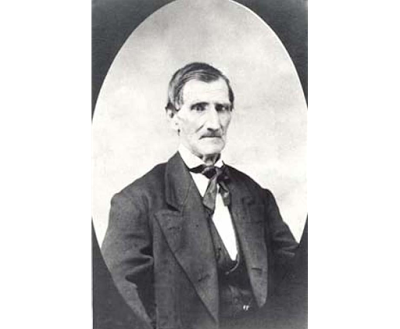 Orange RisdonSurveyor Orange Risdon was commissioned to lay out a practical route in 1825 and was surprised to find how easy the task was by following the Pottawatomie Trail through the Huron Valley to the old Sauk Trail west. Much to the dismay of the settlers, the survey team bypassed Woodruff’s Grove by three-quarters of a mile north. The distance was not much as the crow flies, but it was enough to destroy the dream of a pioneer metropolis. The small village was abandoned and fell into ruin.
Orange RisdonSurveyor Orange Risdon was commissioned to lay out a practical route in 1825 and was surprised to find how easy the task was by following the Pottawatomie Trail through the Huron Valley to the old Sauk Trail west. Much to the dismay of the settlers, the survey team bypassed Woodruff’s Grove by three-quarters of a mile north. The distance was not much as the crow flies, but it was enough to destroy the dream of a pioneer metropolis. The small village was abandoned and fell into ruin.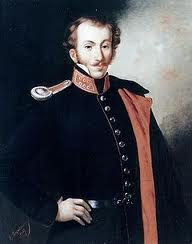 Greek General Demetrios YpsilantiSoon after the new Chicago Road was surveyed, land developers arrived. Judge Augustus Woodward and his business partners—John Stewart and William Harwood—bought the original French Claims on the Huron River. They platted the land into affordable real estate parcels. They christened their new town Ypsilanti after a Greek general prominent in the news of the day. Soon after, a frontier town developed. In 1830, Ypsilanti’s first post office was constructed with regular stage and mail service to Detroit instituted. In 1832, the Michigan legislature officially recognized the frontier town as the Village of Ypsilanti. The land was tamed.
Greek General Demetrios YpsilantiSoon after the new Chicago Road was surveyed, land developers arrived. Judge Augustus Woodward and his business partners—John Stewart and William Harwood—bought the original French Claims on the Huron River. They platted the land into affordable real estate parcels. They christened their new town Ypsilanti after a Greek general prominent in the news of the day. Soon after, a frontier town developed. In 1830, Ypsilanti’s first post office was constructed with regular stage and mail service to Detroit instituted. In 1832, the Michigan legislature officially recognized the frontier town as the Village of Ypsilanti. The land was tamed.
Published on December 30, 2017 16:54
December 28, 2017
2017 Terror In Ypsilanti and Fornology Year End Review
 Photo taken by Nicole Fribourg.
Photo taken by Nicole Fribourg.As 2017 was coming to a close, I thought Terror In Ypsilanti: John Norman Collins Unmasked and Zug Island: A Detroit Riot Novel were all but played out. I began the year with several California and Arizona book talks which were sparsely attended. Fortunately, my books were selling with some regularity on Amazon, and Ebooks sales kicked-in to carry the day.
 In February, I was approached by Tantor Media in Australia for the audio rights to Terror In Ypsilanti. They produced, advertised, and distributed the audio. All I had to do was cash the $500 advance and forget about it. Advances are guaranteed upfront, but royalties don't begin until profits pay back the advance. I thought it would take forever if at all, but I started earning royalties in the third-quarter. That was an unexpected surprise. The audio was selling.
In February, I was approached by Tantor Media in Australia for the audio rights to Terror In Ypsilanti. They produced, advertised, and distributed the audio. All I had to do was cash the $500 advance and forget about it. Advances are guaranteed upfront, but royalties don't begin until profits pay back the advance. I thought it would take forever if at all, but I started earning royalties in the third-quarter. That was an unexpected surprise. The audio was selling.Terror In Ypsilanti and Zug Island are self-published regional stories. Several editors and agents told me there was no audience for them. In April, I did a limited book tour in Ypsilanti, Ann Arbor, and Detroit, Michigan and was surprised when I sold out my stockpile of books. I returned again in July with more books to sell at Bookclub of Detroit's Bookfest. I sold out again. Traveling to Michigan from California to promote my books eats up my profits, but I didn't want the titles to die on the vine. Money has never a motive for writing my books.
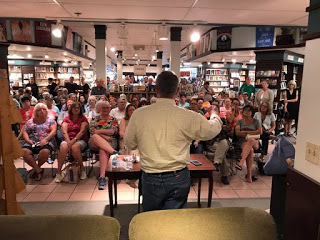 Nicola's Books in Ann ArborTo get regional bookstores to handle Terror In Ypsilanti, I stripped my profit out of the equation to make the book attractive to booksellers. I was more concerned with exposure and distribution than the modest profits the book might bring in. Aunt Agatha's Mystery Bookstore, Nicola's Books, and Barnes & Noble in Ann Arbor agreed to carry my title. The Barnes & Noble in Allen Park--my hometown--also decided to carry the book. There may be others I'm unaware of. All bookstores are welcome to contact my publisher Wheatmark, Inc. for more information. Word of mouth has given my books a life of their own.
Nicola's Books in Ann ArborTo get regional bookstores to handle Terror In Ypsilanti, I stripped my profit out of the equation to make the book attractive to booksellers. I was more concerned with exposure and distribution than the modest profits the book might bring in. Aunt Agatha's Mystery Bookstore, Nicola's Books, and Barnes & Noble in Ann Arbor agreed to carry my title. The Barnes & Noble in Allen Park--my hometown--also decided to carry the book. There may be others I'm unaware of. All bookstores are welcome to contact my publisher Wheatmark, Inc. for more information. Word of mouth has given my books a life of their own.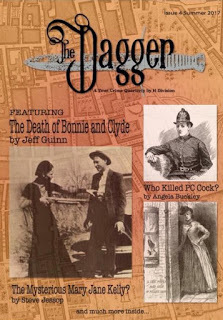 Last spring, I wrote an article about John Norman Collins for The Dagger magazine in London. Months passed and I forgot about it. Early in December, I was notified that the article was published in their quarterly winter edition. This gives my book some international exposure.
Last spring, I wrote an article about John Norman Collins for The Dagger magazine in London. Months passed and I forgot about it. Early in December, I was notified that the article was published in their quarterly winter edition. This gives my book some international exposure.A day or two later, a CBS producer contacted me to see if I'd be interested in being interviewed about the Collins murders for Through the Decades with Bill Kurtis in March. Talk about unexpected! The program will give Terror In Ypsilanti some much needed national exposure when it airs in August. What a nice way to end the year.
Without my Fornology blog posts, I wouldn't have been able to get word out to the public or the media at large about my books. In April 2011, I reluctantly started blogging at the request of my San Diego publicist Paula Margulies. My inner voice told me, "Who the Hell has time for this?" Once I got my posting rhythm down, I found I actually enjoyed blogging and the instant gratification I got from it. More and more people discovered my site and responded positively.
Not only was I building a domestic audience, I also was getting international attention from Russia, Germany, Ukraine, Canada, the United Kingdom, and a vast array of other countries. In the six years since I've been blogging, I've written over 380 posts. On December 26th, I surpassed 500,000 hits. That's half a million, folks. Not bad for a ham-and-egger.
Link to Terror In Ypsilanti audiobook read by professional New York voice artist Chris Ciulla. Here is a five minute sample: https://www.audible.com/pd/Nonfiction/Terror-in-Ypsilanti-Audiobook/B06XSKGMMJ/ref=a_search_c4_2_8_srTtl?qid=1491099172&sr=2-8
Published on December 28, 2017 10:03
December 18, 2017
Detroit's Shock Theater

In 1957, Universal Pictures syndicated a television package of fifty-two classic horror movies released by Screen Gems called Shock Theatre. The package included the original Dracula, Frankenstein, Mummy, and Wolfman movies. Shock Theatre premiered with Lugosi's Dracula in Detroit on WXYZ channel seven at 11:30 pm on February 7, 1958.
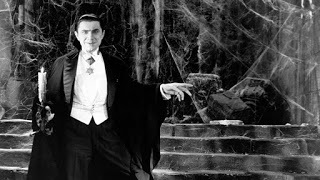 Each syndicated television market had their own host. Detroit had one of the first horror movie personalities in the country. The show was hosted by Mr. X--Tom "Doc" Dougall--a classically trained actor who taught English at the Detroit Institute of Technology and moonlighted as a vampire on Friday nights. Unlike later horror movie hosts who would spoof their roles or riff on the movies they showed, Dougall was grimly serious and set a solemn tone for what was to follow. What most people don't know about Professor Dougall is that he co-wrote several Lone Ranger and Green Hornet scripts for WXYZ radio.
Each syndicated television market had their own host. Detroit had one of the first horror movie personalities in the country. The show was hosted by Mr. X--Tom "Doc" Dougall--a classically trained actor who taught English at the Detroit Institute of Technology and moonlighted as a vampire on Friday nights. Unlike later horror movie hosts who would spoof their roles or riff on the movies they showed, Dougall was grimly serious and set a solemn tone for what was to follow. What most people don't know about Professor Dougall is that he co-wrote several Lone Ranger and Green Hornet scripts for WXYZ radio.The opening of the show was memorable, but I was only nine years old when I started staying up every Friday night to see the classic monsters and mad-scientists--The Invisible Man comes to mind. This is how I remember the opening:
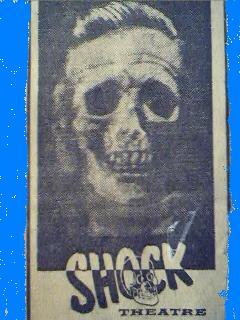 The show's marquee card came up with ominous organ music and a crack of thunder in the background. Replete in vampire grab with cape, Mr. X walked slowly on screen holding a huge open book announcing the night's feature in a scary voice. Next, he would say, "Before we release the forces of evil, insulate yourself against them." With a sense of impending doom, Dr. X continued, "Shut your windows, close your blinds, and lock your doors. Prepare for Shock Theatre." The camera came in for an extreme close-up of Dr. X's face, more lightening and thunder effects, and finally his gaunt face morphed into a skull. Then the film would roll.
The show's marquee card came up with ominous organ music and a crack of thunder in the background. Replete in vampire grab with cape, Mr. X walked slowly on screen holding a huge open book announcing the night's feature in a scary voice. Next, he would say, "Before we release the forces of evil, insulate yourself against them." With a sense of impending doom, Dr. X continued, "Shut your windows, close your blinds, and lock your doors. Prepare for Shock Theatre." The camera came in for an extreme close-up of Dr. X's face, more lightening and thunder effects, and finally his gaunt face morphed into a skull. Then the film would roll.There was something positively unholy about the show which made it an instant success with my generation of ghoulish Detroit Baby Boomers. The show's ominous organ music set the mood for the audience. The piece was listed only as #7 on a recording of Video Moods licensed for commercial television and not available to the public.
No video link to Detroit's Shock Theatre's opening has surfaced, but the above newspaper ad for the show gives an idea of the facial dissolve special effect. If anyone knows where I can find a link, Gmail me so I can add it to this post. Thanks.
Detroit's Baby Boomer Kid Show Hosts:
https://fornology.blogspot.com/2017/12/detroit-baby-boomer-kids-show-hosts.html
Published on December 18, 2017 05:38
December 11, 2017
Detroit Baby Boomer Kids Show Hosts
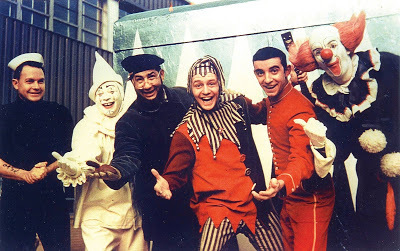 Poopdeck Paul, Milky the Clown, Captain Jolly, Jingles, Johnny Ginger, and Bozo the Clown.
Poopdeck Paul, Milky the Clown, Captain Jolly, Jingles, Johnny Ginger, and Bozo the Clown.Late in 1950, Twin Pines Dairy wanted to sponsor a children's show with cartoons, western movies, and a magic clown called Milky. The dairy owner had seen magician Clare Cummings perform in the Detroit area and offered him the job. Cummings created the Milky makeup and his wife made his costume patterned after the clown in the opera Pagliacci. Milky the Clown was born. Between commercial breaks, Milky performed magic tricks and hosted the day's movie. When he performed his tricks, Milky would always say the magic words "Twin Pines."
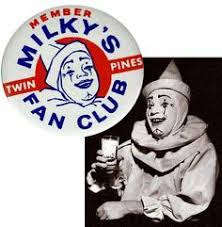
In the days of only four TV broadcasters in the Detroit area, Milky worked at all three American channels. Milky's Movie Party debuted on December 16, 1950 at WJBK-channel two. In 1955, Milky moved to WXYZ--channel seven with the same show except with Little Rascals shorts. In 1958, the show moved for the last time to WWJ--channel four with a slightly different title Milky's Party Time.
Party Time included a live audience and competitions between boys and the girls. Winners would chose a prize from the Twin Pines Toy House. Milky the Clown ended for Cummings in 1964 when he gave up the costume and makeup to make more money in industry.
Clare Cummings died on October 31, 1994, the same day as another noteworthy magician's death in Detroit in 1926--Harry Houdini. Cummings donated most of his magic tricks and one of his costumes to the American Museum of Magic in Marshall, Michigan. They are on permanent display.
***
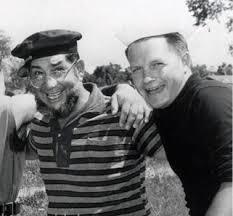 In 1957, Windsor, Ontario broadcaster CKLW--channel nine purchased 234 Max Fleisher Popeye cartoons and they were looking for someone to host Popeye and Friends for their 6:00 pm time slot. Toby David portrayed Captain Jolly. Captain's Jolly's first mate was Poopdeck Paul portrayed by Paul Schultz, who worked the weekend slot. The show was popular but ended in 1964 as CKLW decided to cancel the show. Captain Jolly would address his kiddie audience as his "Chipmates" in his best bad-German accent.
In 1957, Windsor, Ontario broadcaster CKLW--channel nine purchased 234 Max Fleisher Popeye cartoons and they were looking for someone to host Popeye and Friends for their 6:00 pm time slot. Toby David portrayed Captain Jolly. Captain's Jolly's first mate was Poopdeck Paul portrayed by Paul Schultz, who worked the weekend slot. The show was popular but ended in 1964 as CKLW decided to cancel the show. Captain Jolly would address his kiddie audience as his "Chipmates" in his best bad-German accent. ***
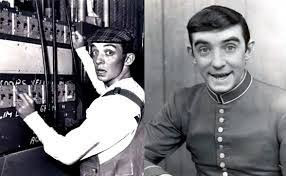
Jerry Gale was working as a stand-up comedian in Toledo, Detroit, and Windsor scratching out a living. In 1957, he auditioned for a new WXYZ program showing Three Stooges shorts called Curtain Time. The station manager insisted that Gale work under the name Johnny Ginger. Ginger's character was dressed as a stagehand in bib overalls. He would open the curtain and close the curtain for every show. Curtain Time ran from 1957 until 1960 when the show was rebranded under the name The Johnny Ginger Show running from 1960 through 1968. Ginger changed his costume to a bellhop uniform and became a fan favorite.
***
Jingles in Boofland was purchased from a Fort Wayne, Indiana station by CKLW in 1958 for their weekly 5:00 pm time slot. Jerry Booth's character was a court jester and not a clown. He wore no makeup. His costume covered with bells jingled whenever he moved.
Jingles lived in the mythical kingdom of Boofland--a play on Booth's last name. The show did not have a studio audience to compromise the fantasy of the medieval castle, the parapet, the archway, and several set pieces which allowed kids watching at home to work their imaginations. His two sidekicks were puppets, Herkimer Dragon and Cecil B. Rabbit.
 Herkimer, Jingles, and Cecil B.Jingles played the straight man reacting to the puppets' eccentric behaviors. The rabbit was a bossy know-it-all. The dragon was a soft-spoken buffoon who did stupid things all the time. Occasional puffs of smoke would come out of Herkimer's mouth. Inside the puppet's head was a tube. Off-stage actor and voice of the puppets Larry Sand would light up a cigarette and blow smoke through the tube creating a fire-breathing dragon effect.
Herkimer, Jingles, and Cecil B.Jingles played the straight man reacting to the puppets' eccentric behaviors. The rabbit was a bossy know-it-all. The dragon was a soft-spoken buffoon who did stupid things all the time. Occasional puffs of smoke would come out of Herkimer's mouth. Inside the puppet's head was a tube. Off-stage actor and voice of the puppets Larry Sand would light up a cigarette and blow smoke through the tube creating a fire-breathing dragon effect.Jingles's comedy skits and running gags were wrapped around the Warner Brothers cartoons and Laurel and Hardy shorts that the program served up. Jingles in Boofland ended in the early sixties. Jerry Booth became Detroit's first Bozo the Clown in 1967.
***
 CKLW Detroit/Windsor Bozo--Art CerviThe original Bozo the Clown was created by Alan W. Livingston in the 1940s for a storytelling record album. The character first appeared on TV in 1949. The rights to Bozo were purchased in 1956 by Larry Harmon. Harmon franchised the character across America, so every major television market had their own Bozo the Clown showing Bozo cartoons.
CKLW Detroit/Windsor Bozo--Art CerviThe original Bozo the Clown was created by Alan W. Livingston in the 1940s for a storytelling record album. The character first appeared on TV in 1949. The rights to Bozo were purchased in 1956 by Larry Harmon. Harmon franchised the character across America, so every major television market had their own Bozo the Clown showing Bozo cartoons.In 1965 when cable TV was taking hold, Harmon began to syndicate Bozo's Circus from Chicago and took the show to a national audience. Individual stations no longer needed their own Bozos, nor could they compete with the new format. In 1978, the show was bouncing off satellites and appearing worldwide.
Jerry Booth's Detroit/Windsor Bozo lasted only a season before Art Cervi took over the role. He donned the red wig and clown suit from 1967 through 1979 when his contract ran out. The above photo of Bozo needs some context. Cervi was doing a live appearance in Tiger Stadium. His makeup and wig are exaggerated so the crowd could see him from a distance. "Whoa, Nelly!" Normally, he wasn't that scary.
***
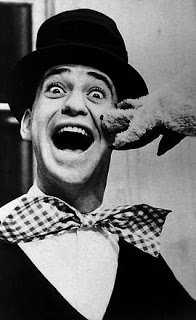 No survey of Detroit's kid show hosts would be complete without mention of the King of Detroit kiddie comedy--Soupy Sales. His show Lunch with Soupy ran at noon on WXYZ from 1953 until 1960.
No survey of Detroit's kid show hosts would be complete without mention of the King of Detroit kiddie comedy--Soupy Sales. His show Lunch with Soupy ran at noon on WXYZ from 1953 until 1960.I remember Lunchtime as a half-hour romp of slapstick, word play, and improvisation. Soupy's signature trademarks were the "pie in the face" and his dance the "Soupy Shuffle." No cartoons, just Soupy and his puppets White Fang, Black Tooth, and Pookie.
Most people are unaware that Milton Supman (Soupy Sales) held a master's degree in journalism. Soupy warrants his own post:
https://fornology.blogspot.com/2017/06/lunch-with-soupy-sales-in-detroit.html
Published on December 11, 2017 05:17
November 30, 2017
5,000 Ways You Know You're From Detroit
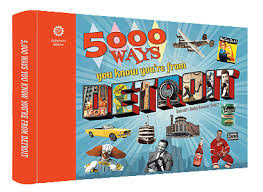
5,000 Ways You Know You're From Detroit (2017) is a treasure trove of memories and images which will resonate with Detroit and Windsor, Ontario area Baby Boomers (1946-1964). But it would be a mistake to think 5,000 Ways is only of interest to the Baby Boomer generation. Anyone with an interest in Detroit's storied past or who wants to learn more about the world their parents and grandparents lived in will find this coffee table book fascinating and informative.
 Walkerville Publishing owners Chris Edwards and Elaine Weeks.
Walkerville Publishing owners Chris Edwards and Elaine Weeks.Chris Edwards and Elaine Weeks say that "5,000 Ways is not meant to be an encyclopedia or an almanac. Our book is more of a personal exploration of life in Detroit primarily after World War II based on an eclectic collection of Detroit stories and photos." Each chapter has a narrative that provides relevant historical context with photographs and lists to enhance the reader's experience.
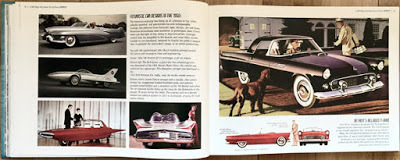
5,000 Ways is not chronological but thematic in its organization. The book can be read cover-to-cover, but it makes a great "jump around" book too. The scope is so broad that no matter how you experience it, you're certain to learn things about the Motor City that will delight and educate you. Of course, the automobile business is well-represented, but chapters on Detroit's music scene, pop culture, fads, shopping centers, and local television personalities will delight young and old alike. But this book doesn't shy away from the city's tragic history and strives to give a balanced account of race relations in the city.
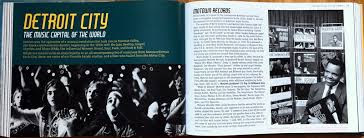
When people discover I'm from Detroit, I often get a condescending response. Too many Americans know Detroit only through photographs of the city's urban ruins at the end of the last century, but they fail to acknowledge the great strides Detroit has made in the twenty-first century. The City of Detroit has a legacy and cache that younger generations of Detroiters and Europeans recognize and are excited about. 5,000 Ways goes a long way to rekindle an appreciation for a wounded city too tough to die.
5,000 Ways is available at select bookstores in the Detroit or Windsor area.
Published on November 30, 2017 09:48
November 20, 2017
Detroit/Windsor Sock-Hop-Jock Robin Seymour
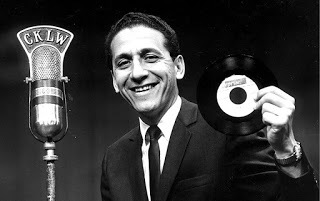 Robin Seymour at the height of his popularity.Robin Henry Seymour began his career in radio as a child actor on The Lone Ranger show on WXYZ in Detroit. Eventually, he became one of the country's most popular disc-jockeys. During World War II, Seymour spent part of his enlistment as a DJ on Armed Forces Radio.
Robin Seymour at the height of his popularity.Robin Henry Seymour began his career in radio as a child actor on The Lone Ranger show on WXYZ in Detroit. Eventually, he became one of the country's most popular disc-jockeys. During World War II, Seymour spent part of his enlistment as a DJ on Armed Forces Radio.Seymour's civilian broadcasting career resumed in 1947 in Dearborn, Michigan at WKMH. The newly formed radio station played mainstream pop music with news, sports, and weather segments. Soon, Seymour became the station's top jock who appealed to many of Detroit and Windsor, Ontario listeners. Seymour championed early rock & roll artists and was one of America's first DJs to play doo-wop music and black rhythm & blues which was labeled race music in those days.
As his popularity grew, Seymour began live appearances with his "Original Rock-n-Roll Revue" at Detroit's legendary Fox Theater. Seymour's personal theme song "Boppin' with the Robin" was recorded in 1956 by a group popular at the time--The Four Lads. They were accompanied by the Percy Faith Orchestra.
Canadian broadcaster CKLW hired Seymour to host a television teen dance show in 1963 entitled Teen Town, modeled on Dick Clark's American Bandstand. Clark's show was broadcast nationally, but Seymour's regional show was wildly popular in the greater Detroit area.
With the help of rising Motown artists, the show gained popularity and was rebranded as Swinging Time. Local teens would dance to Top 40 hits and two kids were chosen from the audience to rate new records with an "aye" or a "nay." National acts performing in Detroit or Windsor appeared on Swinging Time to promote their live shows and records.
Seymour had the good fortune to feature virtually all the Motown artists--The Supremes, Marvin Gaye, Little Stevie Wonder, The Temptations, Martha and the Vandellas, and the list goes on. Swinging Time introduced white suburban teens to local black performers, helping bridge the racial divide in heavily segregated Detroit.
In addition to Motown artists, many local white rock group performers appeared on Seymour's show--people like Glenn Frey, Mitch Ryder, Ted Nugent, and Bob Seger. Because of technical limitations in those days, all of the performers lip-synced their records. The most frequently booked local group on his show was The Rationals--an Ann Arbor garage band.
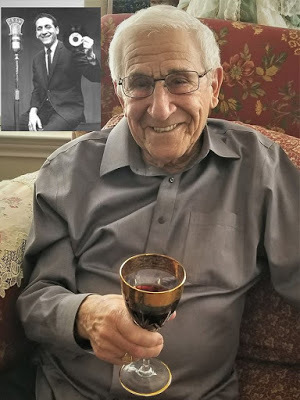 Robin Seymour today.When CKLW changed ownership in 1968, Robin Seymour was replaced by Tom Shannon, another popular Detroit DJ. America was undergoing drastic political and social turmoil and the music reflected that change. Ever try to dance to psychedelic music? The show dropped in the ratings and ended its run in 1969.
Robin Seymour today.When CKLW changed ownership in 1968, Robin Seymour was replaced by Tom Shannon, another popular Detroit DJ. America was undergoing drastic political and social turmoil and the music reflected that change. Ever try to dance to psychedelic music? The show dropped in the ratings and ended its run in 1969.Robin Seymour is in his nineties living in San Antonio, Texas to be near family. He is currently working on his autobiography.
Robin Seymour's "Boppin' with the Robin" theme song: https://www.youtube.com/watch?v=uJFyQuvGG8g
Early Bob Seger performance: https://www.youtube.com/watch?v=LMUrxXwL-NM
Published on November 20, 2017 13:31
November 14, 2017
Bonnie and Clyde's Letter to Henry Ford
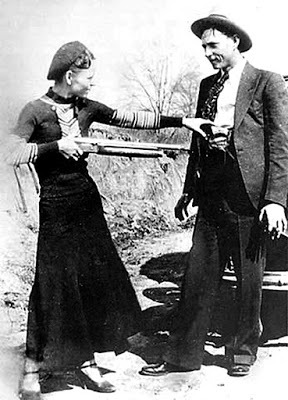 Bonnie and ClydeThe era of the Public Enemy in America was from 1931 through 1935 during the depths of the Great Depression. Names like John Dillinger, Pretty Boy Floyd, Machine Gun Kelly, and Baby Face Nelson blazed across the headlines, but none of these criminals captured the imagination of the American public more than Bonnie Parker and Clyde Barrow, whose daring exploits were romanticized by Midwesterners down on their luck. The press glamorized them in newspapers, news reels, and pulp mystery magazines. Their hardscrabble life on the road was anything but glamorous.
Bonnie and ClydeThe era of the Public Enemy in America was from 1931 through 1935 during the depths of the Great Depression. Names like John Dillinger, Pretty Boy Floyd, Machine Gun Kelly, and Baby Face Nelson blazed across the headlines, but none of these criminals captured the imagination of the American public more than Bonnie Parker and Clyde Barrow, whose daring exploits were romanticized by Midwesterners down on their luck. The press glamorized them in newspapers, news reels, and pulp mystery magazines. Their hardscrabble life on the road was anything but glamorous.When Clyde teamed up with his brother Buck and various other gang members, the press referred to them as the Barrow Gang. Originally, they were cast as underdogs fighting a corrupt banking system and developed the urban myth of robbing the rich and giving to the poor.
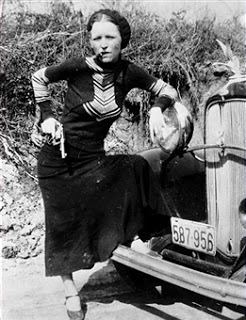 Bonnie Parker with cigar.On March 22, 1933, the gang narrowly escaped capture and left a cache of stolen weapons, a handwritten poem by Bonnie entitled the "Story of Suicide Sal", and a camera with three rolls of undeveloped film. The staged photos led to Bonnie's glamorization. Some showed Bonnie pointing guns at Clyde and one had her smoking a cigar. W.D. Jones, surviving gang member, testified that Bonnie never smoked cigars or shot at any policeman. She did chain smoke Camel cigarettes.
Bonnie Parker with cigar.On March 22, 1933, the gang narrowly escaped capture and left a cache of stolen weapons, a handwritten poem by Bonnie entitled the "Story of Suicide Sal", and a camera with three rolls of undeveloped film. The staged photos led to Bonnie's glamorization. Some showed Bonnie pointing guns at Clyde and one had her smoking a cigar. W.D. Jones, surviving gang member, testified that Bonnie never smoked cigars or shot at any policeman. She did chain smoke Camel cigarettes.Clyde's favorite weapon was the .30 caliber Browning Automatic Rifle (BAR) stolen from an armory. The gang also favored "whippet" guns (sawed-off shotguns) they could conceal under overcoats, and a variety of hand guns. The gang is credited with twelve bank robberies, but they preferred to rob small stores and rural gas stations. They killed nine police officers and a number of civilians who were unfortunate enough to get in their way. Their cold-bloodedness eventually soured the public's perception of the outlaws.
The Texas Department of Corrections contacted retired legendary Texas Ranger Frank A. Hamer. It could be argued that Hamer was more lethal than his quarry Clyde Barrow. Hamer was credited with fifty-three kills and surviving seventeen gunshot wounds. Law enforcement investigators studied the gang's movements and determined to set an ambush for them. The gang swung in a circle of five Midwestern states exploiting the "state line" law that prevented police from pursuing fugitives from one jurisdiction into another.
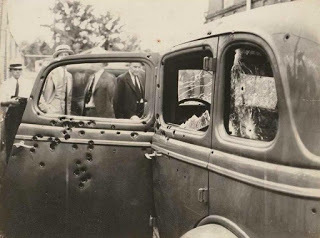 On March 23, 1934 at 9:15 am, a posse of four Texas Rangers and two Louisiana officers hid behind roadside bushes waiting for Bonnie and Clyde to drive by. The posse heard Barrow's stolen Ford V8 speeding down the country road. The car slowed down when Clyde recognized a truck broken down on the side of the dirt road as belonging to a gang member's father whose farm they were hiding out at. When Clyde stopped the car offering to help, the posse opened up on the couple. First they emptied their BARs into the Ford, then they let go with a shotgun barrage, and finally they emptied their handguns. Though legend holds that each body was riddled with as many as fifty rounds apiece, coroner Dr. J.L. Wade's autopsy report documents seventeen bullet wounds on Clyde's body and twenty-six on Bonnie's body. Their remains were buried separately in Texas cemeteries.
On March 23, 1934 at 9:15 am, a posse of four Texas Rangers and two Louisiana officers hid behind roadside bushes waiting for Bonnie and Clyde to drive by. The posse heard Barrow's stolen Ford V8 speeding down the country road. The car slowed down when Clyde recognized a truck broken down on the side of the dirt road as belonging to a gang member's father whose farm they were hiding out at. When Clyde stopped the car offering to help, the posse opened up on the couple. First they emptied their BARs into the Ford, then they let go with a shotgun barrage, and finally they emptied their handguns. Though legend holds that each body was riddled with as many as fifty rounds apiece, coroner Dr. J.L. Wade's autopsy report documents seventeen bullet wounds on Clyde's body and twenty-six on Bonnie's body. Their remains were buried separately in Texas cemeteries.A mere month before their deaths, automobile magnate Henry Ford received a letter proported to be from Clyde himself praising Mr. Ford's new V8 models. This letter is on display at the (Henry) Ford Museum in Dearborn, Michigan.

Handwriting experts dispute the authenticity of the Barrow letter. The cursive does not compare favorably with a letter Clyde wrote to his mother two years earlier, but the letter compares more favorably with Bonnie's handwriting. You be the judge! Compare the writing samples in the link listed below that includes a letter reputed to be sent to Henry Ford by John Dillinger.
Ford letter handwriting samples: http://texashideout.tripod.com/comparison.html
Published on November 14, 2017 03:50
November 5, 2017
The Scarab Club--Heart of Detroit's Arts Scene
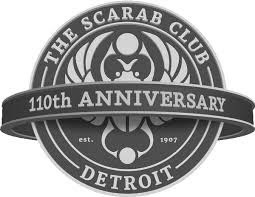 Despite celebrating its one-hundred and tenth anniversary as the center of Detroit, Michigan's artist community, the Scarab Club is relatively unknown to many people in the greater Detroit area. In its heyday, the club held themed costume balls annually from 1917 through the 1950s, with as many as 1,800 Detroiters in attendance.
Despite celebrating its one-hundred and tenth anniversary as the center of Detroit, Michigan's artist community, the Scarab Club is relatively unknown to many people in the greater Detroit area. In its heyday, the club held themed costume balls annually from 1917 through the 1950s, with as many as 1,800 Detroiters in attendance. To revitalize the club, current Executive Director Ashley Hennen told me when I visited in October that the club is rebranding itself to attract more local artists, art lovers, and the general public. In spring of 2016, the Mars Agency was hired to update the club's logo, their website, and their outreach programs. The club's new motto is We Know Detroit by Art.
The original club was named for master marine and landscape painter Robert Hopkins (1832-1909). After a successful showing of his work at The Detroit Museum of Art in 1907, Hopkins and his fellow artists formed an artists' club. They named the Hopkins Club in his honor. The original mission of the club has changed little over the years.
promote the mutual acquaintance of art lovers and artistsstimulate and guide the artistic sense of the people of Detroitadvance the knowledge and love of the fine artsmaintain a clubhouse for entertainment and social purposesand provide working and exhibit facilities for artist members
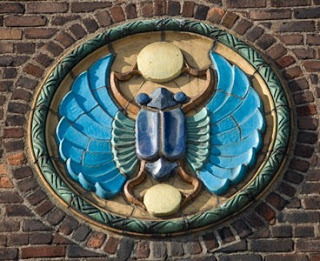 Scarab detail over club entrance.In 1913, the club changed its name to the Scarab Club and adopted the Egyptian symbol of rebirth--the scarab beetle--as its mascot. The three story brick building that currently houses the Scarab Club was designed by member architect Lancelot Sukert and opened in October of 1928. It is located at 217 Farnsworth Street amidst Detroit's Historic Museum District.
Scarab detail over club entrance.In 1913, the club changed its name to the Scarab Club and adopted the Egyptian symbol of rebirth--the scarab beetle--as its mascot. The three story brick building that currently houses the Scarab Club was designed by member architect Lancelot Sukert and opened in October of 1928. It is located at 217 Farnsworth Street amidst Detroit's Historic Museum District.The exterior architecture of the building is Renaissance Revival. A glazed terracotta scarab emblem adorns the south facade. The club has a great deal of history and tradition. The building is listed on the United States National Registry of Historic Places, it is designated a Michigan Historical Site, and it is entered on the Register of Historic Buildings for Detroit.
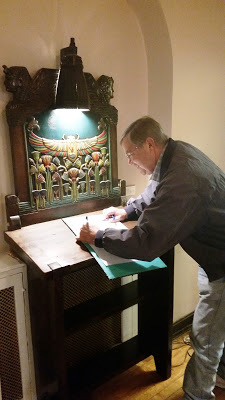 Signing in on October 20, 2017.The interior of the clubhouse is finished in the Arts and Craft style popular in the early twentieth-century. Club member Alfred Nygard carved and painted the scarab panel poised above the guest book as visitors enter the front lobby. The main floor is used as a gallery and performance area. The second floor was a members-only lounge in its early days. Above the fireplace is a mural painted on pine planks by Paul Honore in 1928 entitled "The Scarab Club Family Tree."
Signing in on October 20, 2017.The interior of the clubhouse is finished in the Arts and Craft style popular in the early twentieth-century. Club member Alfred Nygard carved and painted the scarab panel poised above the guest book as visitors enter the front lobby. The main floor is used as a gallery and performance area. The second floor was a members-only lounge in its early days. Above the fireplace is a mural painted on pine planks by Paul Honore in 1928 entitled "The Scarab Club Family Tree."Early in the club's history, the ceiling beams of the members only lounge served as the club's guest book. Poet Vachel Lindsay is said to be the first to sign. Over two-hundred and thirty others have signed the beams including Norman Rockwell, Diego Rivera, Marcel Duchamp, William Milliken (Michigan governor), and John Sinclair. The third floor has six working studios not open to the public.
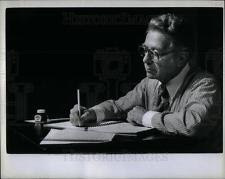 William (Bill) Bostick in 1980.The Scarab Club was originally a men's-only organization. Women were not permitted above the first floor gallery. William Bostick joined the club in 1937 and acted as president and chairman of various committees. He was to become administrator of the Detroit Institute of Arts from 1946 until his retirement in1976. Bostick championed inclusion of women into the club. He remembered his mothers' disappointment when she was not allowed to practice her profession as an archeologist because women were forbidden to go on digs with men. Bostick shamed the club's board to include women for auxillary membership. Women were given full membership rights in 1962.
William (Bill) Bostick in 1980.The Scarab Club was originally a men's-only organization. Women were not permitted above the first floor gallery. William Bostick joined the club in 1937 and acted as president and chairman of various committees. He was to become administrator of the Detroit Institute of Arts from 1946 until his retirement in1976. Bostick championed inclusion of women into the club. He remembered his mothers' disappointment when she was not allowed to practice her profession as an archeologist because women were forbidden to go on digs with men. Bostick shamed the club's board to include women for auxillary membership. Women were given full membership rights in 1962.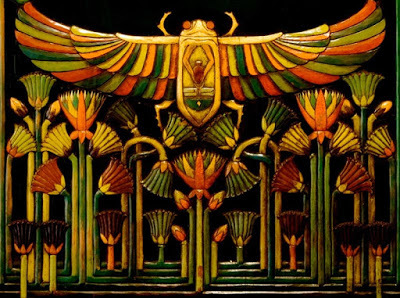 Scarab panel detail.The Scarab Club serves the visual, the literary, and the musical arts. Since 1998, the club has instituted Chamber Music at the Scarab Club and the Blues Heritage Concert Series, but the original mission remains intact. The Scarab Club "continues to be a driving force in the artistic community and is proud to serve Michigan as a cultural stimulant for artistic diversity in the 21st century."
Scarab panel detail.The Scarab Club serves the visual, the literary, and the musical arts. Since 1998, the club has instituted Chamber Music at the Scarab Club and the Blues Heritage Concert Series, but the original mission remains intact. The Scarab Club "continues to be a driving force in the artistic community and is proud to serve Michigan as a cultural stimulant for artistic diversity in the 21st century."For more information contact: www.scarabclub.org
Published on November 05, 2017 07:40



